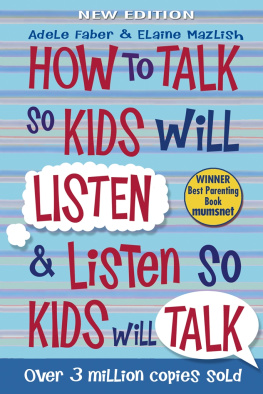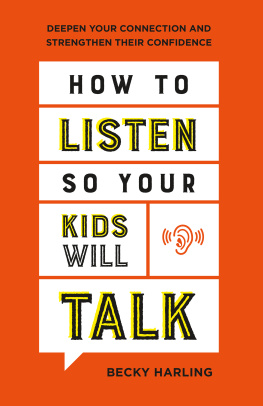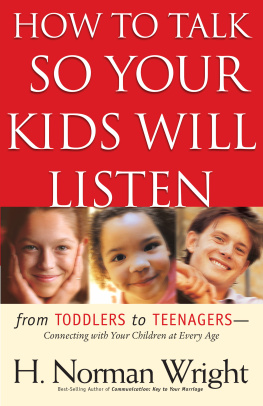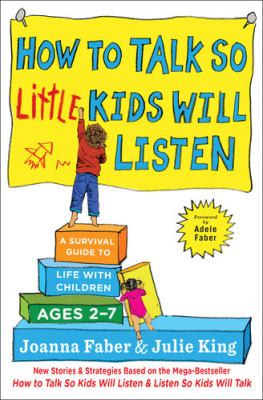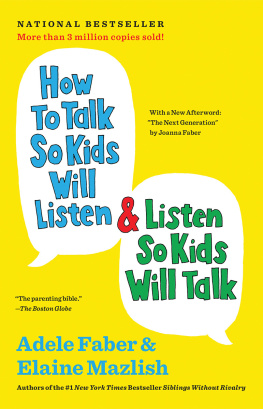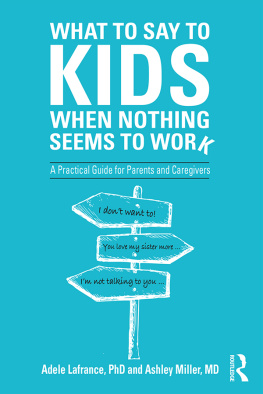
Adele Faber and Elaine Mazlish are internationally acclaimed, award-winning experts on adult-child communication. They lecture throughout the United States and the workshop programmes they have created are being used by thousands of groups around the world to improve communication between adults and children. Their books, printed in twenty languages, have sold over three million copies.
Adele and Elaine both live in Long Island, New York, and each has three adult children.
Books by Adele Faber and Elaine Mazlish,
available from Piccadilly Press:
How to Talk so Kids Will Listen, and Listen so Kids Will Talk
How to Talk so Teens Will Listen, and Listen so Teens Will Talk
Siblings Without Rivalry
How to Talk so Kids Can Learn

First published in Great Britain in 2001
by Piccadilly Press Ltd,
5 Castle Road, London NW1 8PR
www.piccadillypress.co.uk
This 30th anniversary edition published 2013
First edition published by Avon Books, Inc in 1982
Revised edition in 1999
Text copyright 1980, 1999, 2012 Adele Faber and Elaine Mazlish
All rights reserved. No part of this publication may be reproduced, stored in a retrieval system, or transmitted in any form or by any means electronic, mechanical, photocopying, recording or otherwise, without the prior permission of the copyright owner.
The right of Adele Faber and Elaine Mazlish to be identified as Authors of this work has been asserted by them in accordance with the Copyright, Designs and Patents Act, 1988
A catalogue record for this book is available from the British Library
ISBN: 978 1 84812 309 0 (paperback)
ISBN: 978 1 84812 341 0 (ebook)
1 3 5 7 9 11 13 15 17 19 20 18 16 14 12 10 8 6 4 2
Printed in the UK by CPI Group (UK) Ltd, Croydon, CR0 4YY
Cover design by Simon Davis
Acknowledgments
To Leslie Faber and Robert Mazlish, our consultants-in-residence, who were always there for uswith a better phrase, a new thought, a word of encouragement.
To Carl, Joanna, and Abram Faber, to Kathy, Liz, and John Mazlish, who cheered us onjust by being who they are.
To Kimberly Coe, who took our stick figures and scribbled instructions and sent us back drawings of parents and children for whom we felt immediate affection.
To Robert Markel for his support and guidance at a critical time.
To Gerard Nierenberg, friend and advisor, who gave generously of his experience and expertise.
To the parents in our workshops for their thoughtful feedback and written contributions.
To Ann Marie Geiger and Patricia King for giving of themselves unstintingly when we needed them.
To Jim Wade, our editor, whose unflagging good spirits and concern for quality made him a joy to work with.
To Dr. Haim Ginott, who introduced us to new ways of communicating with children. When he died, the children of the world lost a great champion. He cared so much that there be no more scratches on their souls.
A Letter to Readers
Dear Reader,
The last thing we ever thought wed be doing was writing a how-to book on communication skills for parents. The relationship between each parent and child is a very personal and private matter. The idea of giving anyone instructions on how to talk in such a close relationship just didnt feel right to us. In our first book, Liberated Parents/Liberated Children, we tried not to teach or preach. We had a story to tell. Our years of workshops with the late child psychologist Dr. Haim Ginott had affected our lives deeply. We were sure that if we told the story of how our new skills had changed the way we treated both our children and ourselves, that our readers would catch the spirit behind the skills and be inspired to improvise on their own.
To some extent it did work that way. Many parents wrote to tell us proudly of what they had been able to accomplish in their homes just from reading about our experiences. But there were other letters, and a common appeal ran through them all. They wanted a second booka book with lessons... practice exercises... rules of thumb... tear-out reminder pages... some kind of materials that would help them to learn the skills step-by-step.
For a while we considered the idea seriously, but our initial resistance returned and we pushed the thought to the back of our minds. Besides, we were too busy concentrating on the speeches and workshops we were preparing for our lecture tours.
During the next few years we traveled around the country, conducting workshops for parents, teachers, school principals, hospital staffs, teenagers, and child-care workers. Wherever we went, people shared with us their personal experiences with these new methods of communicationtheir doubts, their frustrations, and their enthusiasm. We were grateful to them for their openness and we learned from them all. Our files were bulging with exciting new material.
Meanwhile, the mail continued to come in, not only from the United States but from France, Canada, Israel, New Zealand, the Philippines, India. Mrs. Anagha Ganpule from New Delhi wrote:
There are so many problems about which I would like to take your advice.... Please let me know what I could do to study the subject in depth. I am at a dead end. The old ways do not suit me, and I do not have the new skills. Please help me get over this.
That was the letter that did it.
We started to think again about the possibility of writing a book that showed how. The more we talked about it, the more comfortable we became with the idea. Why not a how-to book with exercises so that parents could teach themselves the skills they wanted to know?
Why not a book that would give parents a chance to practice what theyve learned at their own paceeither by themselves or with a friend?
Why not a book with hundreds of examples of helpful dialogues so that parents could adapt this new language to their own personal style?
The book could have cartoons that would show the skills in action, so that a harried parent could glance at a picture and give himself or herself a quick refresher course.
Wed personalize the book. Wed talk about our own experiences, answer the most commonly asked questions, and include the stories and new insights that parents in our groups have shared with us over the past six years. But, most important, wed always keep sight of our larger goalthe constant search for methods that affirm the dignity and humanity of both parents and children.
Suddenly our original uneasiness about writing a how-to book vanished. Every other art or science has its skill books. Why not one for parents who want to learn how to talk so their kids will listen, and listen so their kids will talk?
Once we decided, we started writing rapidly. We hope to get a complimentary copy off to Mrs. Ganpule in New Delhi before her children are grown.
Adele Faber
Elaine Mazlish
How to Read
and Use This Book
It seems presumptuous for us to be telling anyone else how to read a book (particularly when both of us have been known to start books in the middle or even read them backward). But since this is our book wed like to tell you how we think it should be tackled. After youve gotten the feel of it by flipping through and glancing at the cartoons, start with Chapter I. Actually do the exercises as you go along. Resist the temptation to skip over them and get to the good parts. If you have a compatible friend with whom to work on the exercises, so much the better. We hope youll talk and argue and discuss your answers at length.
Next page
